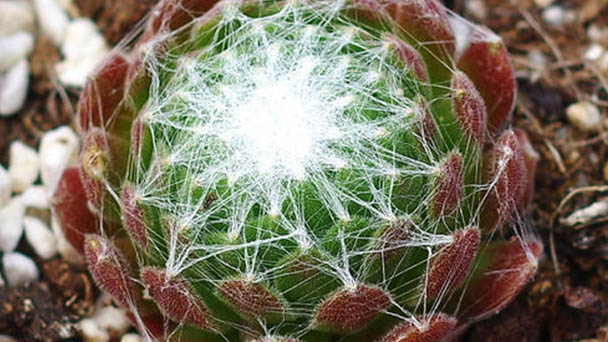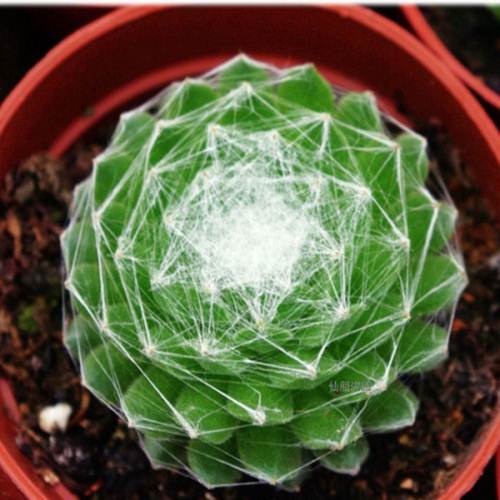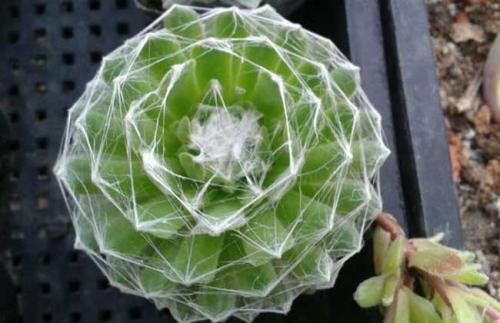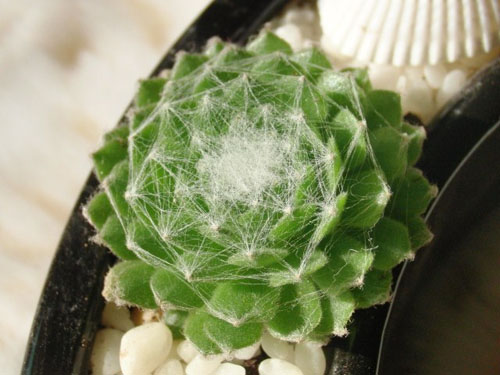Cobweb hen and chick profile
Written by Maggie
Feb 03 2021

Cobweb hen and Chick, scientific name Sempervivum arachnoideum, is a succulent perennials of the genus Cobweb and Chick, native to South Central Europe, North Africa, Caucasus, and Asia Minor. Cobweb hen and Chick, Guanyin rosette type, leaf ring, leaf flat long and thin, leaf tip has white silk.
Cobweb hen and chick picture

Cobweb hen and chick morphological characteristics
Individual Cobweb hen and chick (Sempervivum arachnoideum) diameter is 1.5-3.5 cm. Cobweb hen and chick are shorter, nearly spherical, and grow close to the ground. There are plenty of spiderweb-like hairs around the tip of the leaf, but wild plants may lose them in autumn and winter. In the wild state, the leaves are very closely arranged and easily divided into plants. When the lateral buds grow up, they form dense clusters. Cobweb hen and chick have flat leaves, generally light green, bamboo - shaped, slightly pointed top.Petals pink with dark stripes.
Cobweb hen and chick's ecological habits
Cobweb hen and Chick (Sempervivum arachnoideum) are winter type (winter type, dormant in summer). They are hardy, heat sensitive, ventilated, and perishable in summer. Cobweb hen and chick are pleasant to cool and sunny environments, avoid hot and humid, cold resistance, and summer high temperature dormancy. Spring and autumn are the growing seasons, with full sunshine. Moderate shading, ventilation and controlled watering during the summer dormant period, otherwise highly perishable. Under the irradiation of the sun, the top of the Cobweb hen and chick leaf is easy to turn red, another touching. Cobweb hen and Chick is gorgeous when it blossoms, but each time it blooms, it's the end of its life. Cobweb hen and Chick, however, does not grow very slowly and is very easy to grow in groups.
Cobweb hen and Chick (Sempervivum arachnoideum) grows fast and grows easily in groups.Pleasant to cool and sunny environment, avoid hot and humid, cold resistance, summer high temperature dormancy. Spring and autumn are the growing seasons.T he abaxial surface of Cobweb hen and chick leaves turns red or purple in the environment of good drainage of soil, sufficient sunlight and large temperature difference (or low temperature). Cobweb hen and chick die after flowering, so they can be pollinated or divided during the flowering period.
Cobweb hen and chick distribution region
Cobweb hen and chick (Sempervivum arachnoideum) is native to Central and Southern Europe, North Africa Caucasus and Asia Minor, mainly distributed in Southwest Europe, now can be grown in many parts of the world.
Cobweb hen and chick propagation method
1. Cobweb hen and chick (Sempervivum arachnoideum) division propagation. Division propagation is the most common method of Cobweb Hen and Chick propagation. First of all, take off the small side bud, put the small side bud in clean water, and then put it in a cool place for drying, until drying, then use. Next is to prepare slightly wet soil on the pot inside, do not compact, keep loose. Undertake cuttage, the side bud difference that air basks in directly inserted into the soil, the next cool ventilated place maintains, you need to wait for the hair root to be OK.
Cobweb hen and chick (Sempervivum arachnoideum) are also commonly used for propagation. As long as it is a ramet plant, it can be propagated by means of Cobweb hen and chick. Breeding when you want to use out of the branch sprouts, leaf insertion is also very easy, so the use of leaf insertion, branch insertion is convenient and simple, and the survival rate can also be high.

Cobweb hen and Chick growing method
The temperature
Cobweb hen and chick (Sempervivum arachnoideum) grow at the appropriate temperature between 15℃ and 25℃. Cobweb hen and chick will stop growing when the temperature is below 5 °C.So you have to keep a certain temperature when you're farming.
Soil
Cobweb hen and Chick's growing environment requires good soil drainage, so consider carefully when selecting the soil. Peat mixed with perlite and coal cinder should be used in a roughly 1:1:1 ratio. To allow air to flow and prevent the plant from touching the surface of the soil, cover it with a layer of clean, granular river sand, no more than 5mm in size.
Watering
Cobweb hen and Chick (Sempervivum arachnoideum) avoid moisture and heat, so reduce the number of watering, but the amount of watering should be gradually increased with the rise of temperature, follow the principle of "water thoroughly until the soil is dry, dry no watering".
Fertilization
Spring fertilization for Cobweb hen and chick (Sempervivum arachnoideum) should be based on nitrogen fertilizer, phosphorus and potassium fertilizer as a supplement, pay attention to thin fertilizer application. It is best to wait until the temperature stabilizes in the spring before applying fertilizer.
In the lower reaches of the river, fertilization around spring can have a great effect.
Disease Control of cobweb Hen and chick
Cobweb hen and Chick (Sempervivum arachnoideum) insect pest is most common in the root mealybug, which can be prevented by burying Carbofuran or Carbofuran in the soil. Avermectin is injected once a year in summer and again in winter. It can also be used to protect the flower god irrigation root treatment. Cultivation in the open air also provides some protection against common scale insects.
Cobweb hen and Chick diseases (Sempervivum arachnoideum) are mainly black rot, which occurs most often in summer. The symptoms are black, soft and rotting at the roots, undersides of the leaves or the heart of the leaves. They are usually caused by excessive humidity, heat, poor ventilation or scale insects. If the root or the bottom of the leaf blackened, it can be dug out in the early stage, clean up the rotting roots and leaves, if necessary, can be cut down the rotting stem, on the dry soil re rooting (specific with cuttings). But if the heart of the Cobweb hen and chick leaf rotts, survival may not be much. After the occurrence of black rot, it should be as soon as possible to dig out the infected plant or isolation, to avoid bacterial infection.
Cobweb Hen and Chick main value
Cobweb hen and Chick (Sempervivum arachnoideum) is unique and beautiful in shape. The pale green leaves are arranged in a circular rosette, and the white light silk on the tip of the leaves is particularly unique. The protruded side buds are lovely like small green bells. Planted Cobweb hen and chick in the rough plain style of stone or cement texture basin, with large grain plain stone pavement, very elegant; Randomly planted in the courtyard, a cluster of blossoming green lotus next to escape oblique, more show the beauty of the wild; Cobweb hen and chick can match with light color preservative wood container to have one kind of European style pastoral flavor.

Latest Updated
- Benefits of Bugleweed - 7 Science-backed Health Benefits
- Bugleweed Dangers & Side Effects - Is It Poisonous?
- How to Plant Evergreen Trees - What You Should Know
- When to Plant Evergreens - Grow Guide for Evergreen Trees
- 12 Wonderful Evergreen Shrubs for Your Garden
- 12 Popular Evergreen Plants with Pictures for Beginners
- When And How To Prune A Lilac Bush Like a Pro
- How to Grow & Care for Lilac Vine (Hardenbergia Violacea)
- Japanese Lilac Tree (Syringa Reticulata) Care & Propagation Guide
- Shumard Oak Pros and Cons - What to Know
Popular Articles
- Winter maintenance of Antirrhinum Majus
- How to Grow Terminalia Mantaly Tree
- How to Grow and Care for Crossostephium Chinense
- How to grow Antirrhinum Majus in spring
- Peristeria Elata (Dove Orchid) Profile: Info & Care Guide
- Underwatered Snake Plant (Sansevieria Trifasciata) - Signs And How To Fix
- How to Care for Brazilian Jasmine Plant (Mandevilla Sanderi)
- How to Grow & Care for Graptopetalum Purple Delight in Summer
- Rosa Chinensis (China Rose): Plant Growing & Care Tips
- How to Care for Baby Sun Rose (Aptenia Cordifolia)